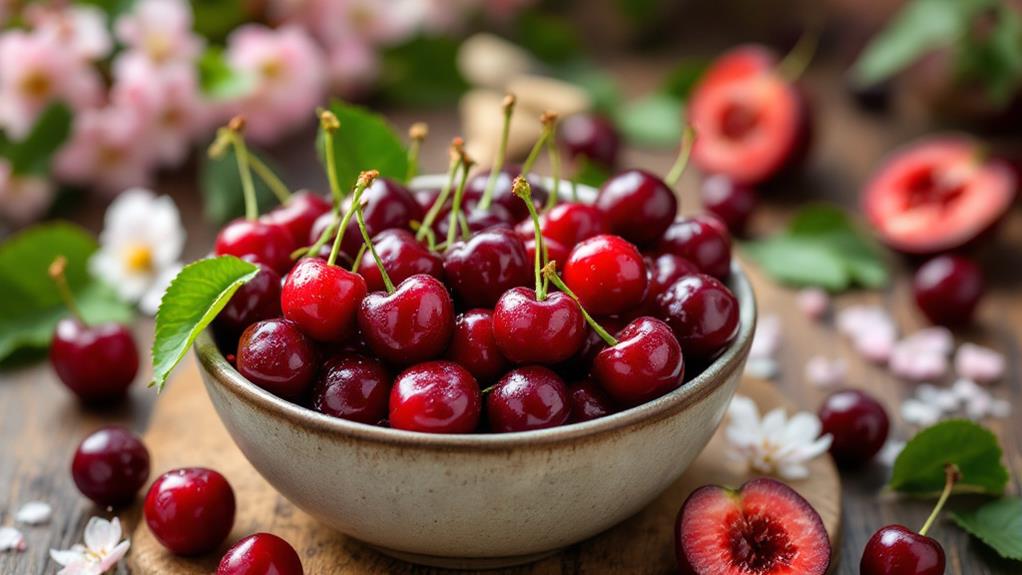Discover Muntingia: Unique Properties of the Fruit and Flower of Health
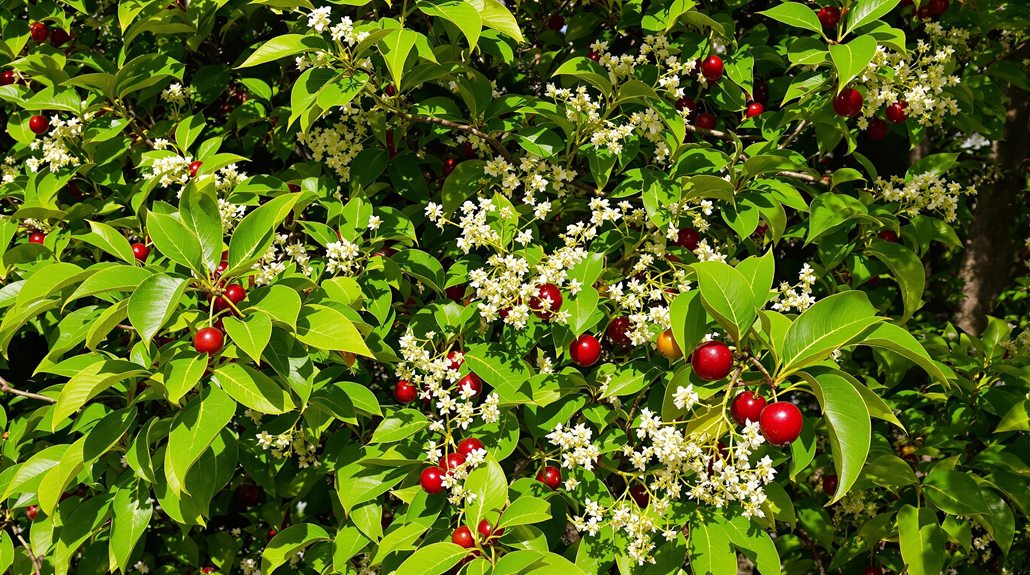
Uncover Muntingia's hidden potential with its fruit and flower's remarkable health benefits. Known for its antioxidant and anti-inflammatory properties, Muntingia, an evergreen tree, offers a bounty of traditional medicinal uses. The sweet fruit is rich in flavonoids, while the flowers have been used as tranquilizers and tonics. The leaves help with ulcers and diabetes, showcasing their healing power. They also contain bioactive compounds like alkaloids and tannins, enhancing their pharmacological benefits. With antimicrobial effectiveness against common bacteria and fungi, it's highly versatile. There's more to reveal about this fascinating plant's therapeutic promise.
Traditional Uses of Muntingia
Muntingia calabura, often celebrated for its medicinal properties, frequently finds its place in traditional remedies across different cultures. In Peru, you can use the flowers and bark of Muntingia for their antiseptic properties to reduce swelling, making it a staple in traditional medicine. An infusion of its flowers serves as a tranquilizer and tonic in Colombian practices, highlighting its adaptability within local health care systems.
If you're dealing with gastric ulcers, steaming Muntingia leaves is a common method in several cultures, reflecting its medicinal applications. In Mexico, the fruit and distinct parts of the plant help alleviate symptoms of measles, mouth pimples, and stomach aches. These folk remedies showcase the plant's importance in addressing everyday ailments.
Over in the Philippines, Muntingia's flowers are utilized to tackle headaches and serve as an antispasmodic, underlining the plant's role in traditional health care systems. Across these regions, Muntingia's assorted uses emphasize its valued place in traditional medicine. Regardless of its antiseptic properties or as a soothing infusion, Muntingia calabura remains a trusted ally in natural healing practices.
Botanical Characteristics
While Muntingia calabura has earned its place in traditional medicine, understanding the plant's botanical characteristics offers insight into its unique properties. As a small evergreen tree, it can grow between 3 to 12 meters tall. You'll notice its lanceolate leaves, which are dark green and measure about 5 to 12.5 cm long, giving the tree its lush appearance. Originating from southern Mexico and tropical South America, Muntingia calabura has adapted well to diverse environments and is now cultivated in regions like Southeast Asia and the Maldives.
The tree's charm lies in its continuous flowering, a trait that guarantees a year-round supply of food for wildlife and humans alike. Its small white flowers, about 1.25 to 2 cm across, are striking with five green sepals, five white petals, and lively yellow stamens at their centers. These flowers give way to round fruits, measuring 1 to 1.25 cm wide. The fruits, which differ in color from red to yellow, are known for their sweet, juicy, and edible pulp. They're often enjoyed fresh or transformed into delightful jams, making Muntingia calabura a cherished plant in its cultivated regions.
Chemical Composition
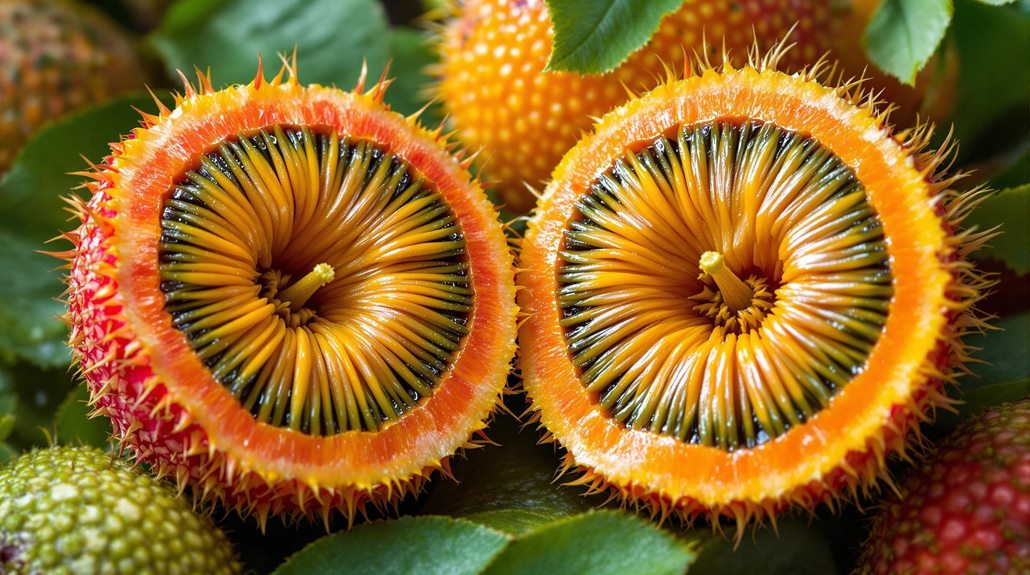
The chemical-rich profile of Muntingia calabura is both fascinating and beneficial, contributing considerably to its traditional medicinal use. You'll find that the fruit is packed with carbohydrates, boasting a concentration of 204.0 mg/g. This not only gives it a delightful sweetness but also improves its nutritional value. The leaves and stems are gems of bioactive compounds like alkaloids, tannins, flavonoids, and phenolic compounds, with an impressive total yield of 9.95% from certain extracts.
Flavonoids, including pinocembrin and chrysin, are key players in Muntingia calabura, supporting its antioxidant activity and anti-inflammatory properties. New revelations in its chemical profile reveal dihydroxy and methoxy flavonoids, adding depth to its medicinal uses. Methanolic extracts from this plant show remarkable antioxidant activity, with radical scavenging efficiency reaching up to 99.9%.
Here's a quick look at the chemical composition:
| Component | Concentration/Activity | Role |
|---|---|---|
| Carbohydrates | 204.0 mg/g | Nutritional value |
| Flavonoids | Varied | Antioxidant, anti-inflammatory |
| Radical Scavenging | 92.1% - 99.9% | Antioxidant activity |
Muntingia calabura's unique chemical profile undeniably contributes to its health-boosting reputation.
Health Benefits
Bursting with bioactive compounds, the Muntingia calabura plant is a powerhouse of health benefits. Its fruits are loaded with flavonoids and phenolic compounds that provide potent antioxidant properties, helping you combat oxidative stress and protect your cells from damage. These antioxidants play a vital role in reducing the risk of chronic diseases and promoting general well-being.
If you're concerned about blood sugar levels, Muntingia calabura leaves might be your answer. They exhibit impressive anti-diabetic effects, reducing blood glucose levels by up to 24.81% at a specific dosage. This could be beneficial for managing diabetes and enhancing metabolic health.
For those struggling with gastric issues, the plant's ethanolic extracts offer anti-ulcer activity. They reduce gastric acidity and increase mucus production, providing relief and protection against ulcers.
Inflammation is another area where M. calabura shines. Its anti-inflammatory properties effectively reduce edema, offering potential relief from inflammatory conditions. Moreover, if heart health is a priority, the plant's aqueous extracts demonstrate cardioprotective effects by lowering serum markers in myocardial infarction models. Incorporating Muntingia calabura into your lifestyle could offer a natural enhancement to your health.
Pharmacological Effects
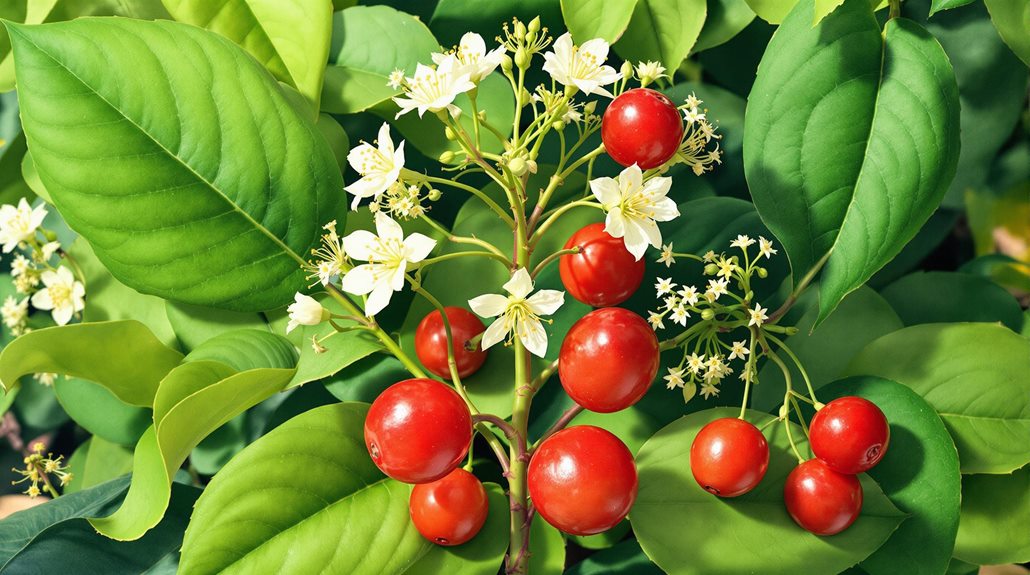
Among the pharmacological marvels of Muntingia calabura, its anti-inflammatory properties stand out prominently. You'll find that studies have shown its effectiveness in reducing carrageenan-induced edema in animal models, making it a potent option for managing inflammation. But that's not all Muntingia offers. Its leaves possess impressive anti-ulcer activity, greatly decreasing gastric acidity and enhancing mucus production, which can be beneficial for those suffering from ulcers.
Moreover, if you're looking to manage blood sugar levels, Muntingia's methanolic extracts have displayed hypoglycemic effects, achieving a remarkable 24.81% reduction in blood glucose at a 500 mg/kg dosage. This could be a valuable supplement to your health regimen for maintaining balanced glucose levels.
In terms of antioxidant activities, the high flavonoid content in Muntingia's fruit and leaves plays an essential role in scavenging free radicals and protecting against oxidative stress. Furthermore, its extracts have exhibited cytotoxic effects against cancer cell lines, indicating potential medicinal uses in cancer treatment. Embracing Muntingia's pharmacological effects could lead to considerable health benefits, thanks to its diverse array of therapeutic properties.
Antimicrobial Properties
Muntingia calabura's antimicrobial properties are impressive and varied, offering promising benefits against different pathogens. You'll find that the methanol extracts from Muntingia calabura fruits exhibit considerable antibacterial activity. They effectively combat pathogens like E. coli and S. aureus, with minimum inhibitory concentration values of 512 µg/ml and 128 µg/ml, respectively. This suggests the fruit's potential as a powerful natural antimicrobial agent.
But it's not just the fruits that shine. Multiple parts of the plant, including leaves and bark, further extend these antimicrobial effects. Methanol extracts from these parts are particularly potent against a range of bacterial and fungal pathogens. For instance, they've shown effectiveness against fungi such as A. solani and Fusarium oxysporum, with notable zones of inhibition in agar well diffusion assays. This highlights the plant's all-encompassing health benefits.
Incorporating Muntingia calabura into pharmaceutical and food industry applications could offer a natural alternative to synthetic antimicrobials. With its broad-spectrum activity and potential health benefits, Muntingia calabura stands out as a valuable source of natural antimicrobial agents. Embracing these properties could greatly improve your approach to managing pathogens.
Antioxidant Activities
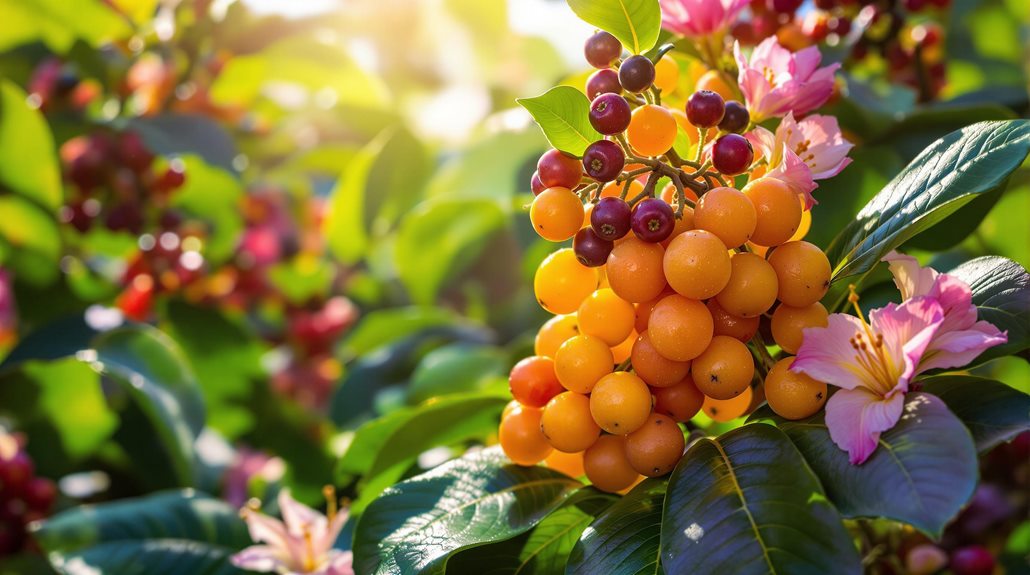
How remarkable are the antioxidant activities of Muntingia calabura? You'll be amazed to learn that its leaves exhibit a significant antioxidant activity, with methanolic extracts demonstrating an impressive radical scavenging potential ranging from 92.1% to 99.9% in DPPH assays. This highlights the plant's robust capacity to neutralize free radicals, making it a powerful ally in combating oxidative stress.
The secret behind this remarkable antioxidant activity lies in the bioactive compounds present in Muntingia calabura, particularly flavonoids and phenolic compounds. These compounds are known for their ability to retard oxidative degradation of lipids, thereby enhancing the nutritional value of foods. This makes extracts of M. calabura leaves highly appealing to the food industry, which is always in search of natural ways to improve food products.
Furthermore, the antioxidant capacity of Muntingia calabura supports its traditional use across diverse cultures, where it's valued for its health benefits and potential medicinal applications. The rich yield of bioactive compounds, reported at 9.95%, underscores its importance as a natural source of antioxidants. Welcome the potential of this extraordinary plant in enhancing your health and well-being!
Future Research Opportunities
Exploration into the future research opportunities of Muntingia calabura opens a domain of possibilities for scientific advancement. You'll find that isolating and characterizing its bioactive compounds is essential to validating its traditional medicinal uses. This process could reveal its therapeutic potential, offering new avenues for developing treatments. Immerse yourself in the antiproliferative activities of M. calabura extracts, as their limited study reveals promising, yet underexplored, results that could revolutionize cancer research.
M. calabura's antimicrobial properties deserve your attention too. Research should aim to assess its effectiveness against a wider range of bacterial and fungal pathogens. Such studies might uncover new, natural alternatives to conventional antibiotics. Investigating the phytochemical diversity of this plant is another promising area. Examine different parts of M. calabura, considering how chemical profiles vary based on extraction methods and environmental factors.
Ethnobotanical studies can improve your understanding of M. calabura's traditional uses across diverse cultures. By documenting and preserving indigenous knowledge, you not only honor cultural heritage but also create new pathways for medical innovation. Seize these opportunities to contribute to a deeper understanding of this unique plant.
Challenges and Considerations
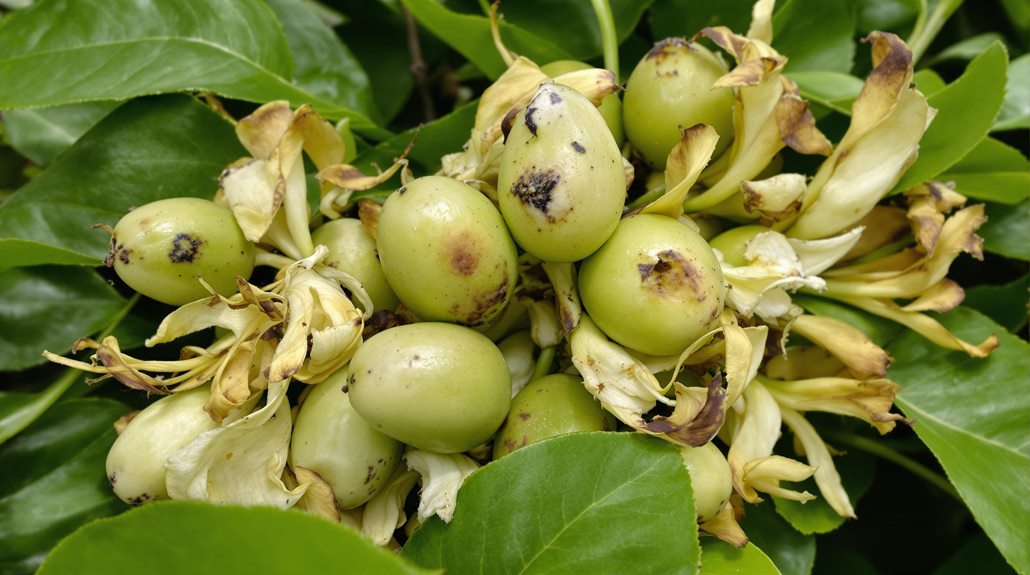
Understanding the challenges and considerations surrounding Muntingia calabura is vital for its effective use in both traditional and modern medicine. Despite its medicinal potential, this plant remains under-researched, especially in regions like Malaysia, creating a gap in understanding its traditional uses and health benefits. The limited scientific studies on its specific pharmacological activities mean that further exploration is important to validate traditional claims and uncover new therapeutic applications.
One major challenge lies in the variability of its chemical composition. Factors such as extraction methods and environmental conditions can considerably influence this, complicating efforts to standardize the potency and efficacy of Muntingia calabura extracts. This inconsistency can hinder its integration into modern medical practices where uniformity is key.
Moreover, while the plant offers many potential health benefits, thorough safety assessments and toxicity studies are needed to guarantee its safe use. Given the diverse pharmacological activities of M. calabura, these evaluations become even more vital.
Additionally, Muntingia calabura's invasive nature in some regions raises concerns about possible ecological impacts. Careful management of cultivation and harvesting practices is necessary to mitigate these risks while capitalizing on the plant's medicinal value.




